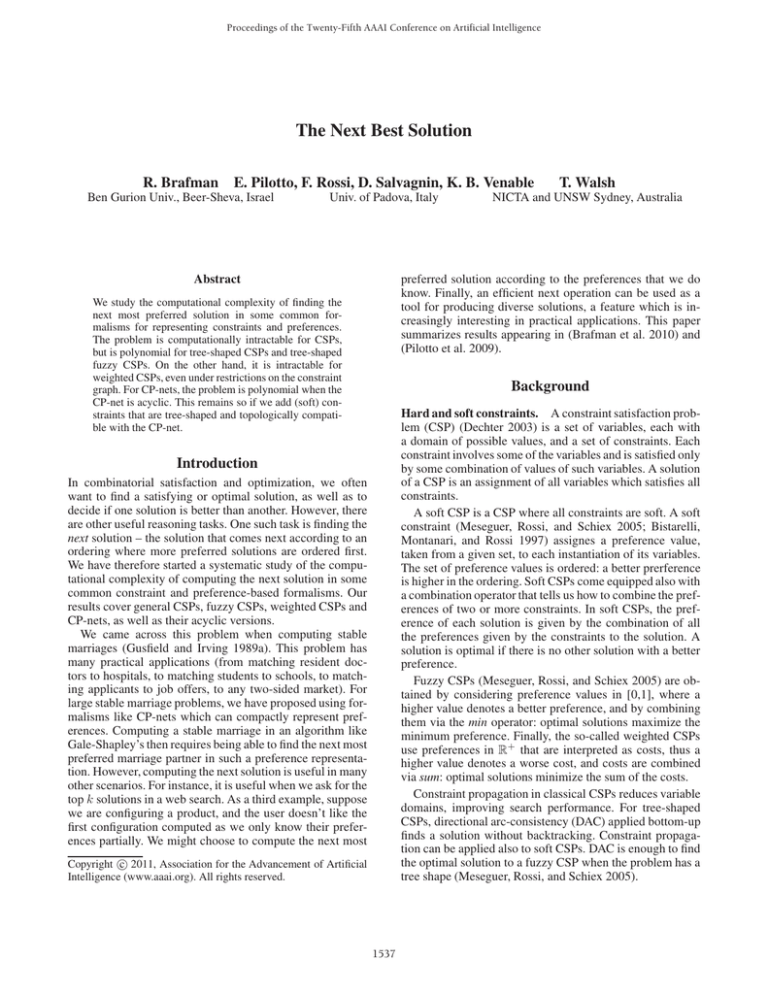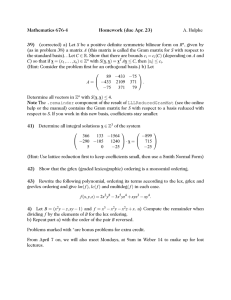
Proceedings of the Twenty-Fifth AAAI Conference on Artificial Intelligence
The Next Best Solution
R. Brafman
E. Pilotto, F. Rossi, D. Salvagnin, K. B. Venable
Ben Gurion Univ., Beer-Sheva, Israel
Univ. of Padova, Italy
T. Walsh
NICTA and UNSW Sydney, Australia
preferred solution according to the preferences that we do
know. Finally, an efficient next operation can be used as a
tool for producing diverse solutions, a feature which is increasingly interesting in practical applications. This paper
summarizes results appearing in (Brafman et al. 2010) and
(Pilotto et al. 2009).
Abstract
We study the computational complexity of finding the
next most preferred solution in some common formalisms for representing constraints and preferences.
The problem is computationally intractable for CSPs,
but is polynomial for tree-shaped CSPs and tree-shaped
fuzzy CSPs. On the other hand, it is intractable for
weighted CSPs, even under restrictions on the constraint
graph. For CP-nets, the problem is polynomial when the
CP-net is acyclic. This remains so if we add (soft) constraints that are tree-shaped and topologically compatible with the CP-net.
Background
Hard and soft constraints. A constraint satisfaction problem (CSP) (Dechter 2003) is a set of variables, each with
a domain of possible values, and a set of constraints. Each
constraint involves some of the variables and is satisfied only
by some combination of values of such variables. A solution
of a CSP is an assignment of all variables which satisfies all
constraints.
A soft CSP is a CSP where all constraints are soft. A soft
constraint (Meseguer, Rossi, and Schiex 2005; Bistarelli,
Montanari, and Rossi 1997) assignes a preference value,
taken from a given set, to each instantiation of its variables.
The set of preference values is ordered: a better prerference
is higher in the ordering. Soft CSPs come equipped also with
a combination operator that tells us how to combine the preferences of two or more constraints. In soft CSPs, the preference of each solution is given by the combination of all
the preferences given by the constraints to the solution. A
solution is optimal if there is no other solution with a better
preference.
Fuzzy CSPs (Meseguer, Rossi, and Schiex 2005) are obtained by considering preference values in [0,1], where a
higher value denotes a better preference, and by combining
them via the min operator: optimal solutions maximize the
minimum preference. Finally, the so-called weighted CSPs
use preferences in R+ that are interpreted as costs, thus a
higher value denotes a worse cost, and costs are combined
via sum: optimal solutions minimize the sum of the costs.
Constraint propagation in classical CSPs reduces variable
domains, improving search performance. For tree-shaped
CSPs, directional arc-consistency (DAC) applied bottom-up
finds a solution without backtracking. Constraint propagation can be applied also to soft CSPs. DAC is enough to find
the optimal solution to a fuzzy CSP when the problem has a
tree shape (Meseguer, Rossi, and Schiex 2005).
Introduction
In combinatorial satisfaction and optimization, we often
want to find a satisfying or optimal solution, as well as to
decide if one solution is better than another. However, there
are other useful reasoning tasks. One such task is finding the
next solution – the solution that comes next according to an
ordering where more preferred solutions are ordered first.
We have therefore started a systematic study of the computational complexity of computing the next solution in some
common constraint and preference-based formalisms. Our
results cover general CSPs, fuzzy CSPs, weighted CSPs and
CP-nets, as well as their acyclic versions.
We came across this problem when computing stable
marriages (Gusfield and Irving 1989a). This problem has
many practical applications (from matching resident doctors to hospitals, to matching students to schools, to matching applicants to job offers, to any two-sided market). For
large stable marriage problems, we have proposed using formalisms like CP-nets which can compactly represent preferences. Computing a stable marriage in an algorithm like
Gale-Shapley’s then requires being able to find the next most
preferred marriage partner in such a preference representation. However, computing the next solution is useful in many
other scenarios. For instance, it is useful when we ask for the
top k solutions in a web search. As a third example, suppose
we are configuring a product, and the user doesn’t like the
first configuration computed as we only know their preferences partially. We might choose to compute the next most
c 2011, Association for the Advancement of Artificial
Copyright Intelligence (www.aaai.org). All rights reserved.
1537
tion of the solution ordering, lex(O), where given two variable assignments, s and s , we write s ≺lex(O) s (that is,
s precedes s ) if either s is a solution and s is not, or s
precedes s in the lexicographic order induced by O (that
is, s = (s1 , . . . , sn ), s = (s1 , . . . , sn ), and there exists
i ∈ [1, n] such that si ≺oi si and sj = sj for all j < i).
For the linearization lex(O), the problem of finding the next
solution is computationally intractable.
CP-nets. CP-nets (Boutilier et al. 2004a) are a graphical
model for compactly representing conditional and qualitative preference relations. CP-nets are sets of ceteris paribus
(cp) preference statements. A CP-net has a set of features
F = {x1 , . . . , xn } with finite domains D(x1 ), . . . ,D(xn ).
For each feature xi , we are given a set of parent features
P a(xi ) that can affect the preferences over the values of
xi . This defines a dependency graph in which each node xi
has P a(xi ) as its immediate predecessors. Given this structural information, the agent explicitly specifies her preference over the values of xi for each complete assignment on
P a(xi ). This preference is assumed to take the form of total or partial order over D(xi ). An acyclic CP-net is one in
which the dependency graph is acyclic.
The semantics of CP-nets depends on the notion of a
worsening flip. This is the change in the value of a variable to
a less preferred value according to the cp statement for that
variable. One outcome α is better than another outcome β
(written α β) iff there is a chain of worsening flips from α
to β. This induces a preorder over the outcomes, and a partial
order if the CP-net is acyclic. In general, finding the optimal
outcome of a CP-net, as well as comparing two outcomes,
is NP-hard (Boutilier et al. 2004a). However, in acyclic CPnets, there is only one optimal outcome which can be found
in linear time by sweeping through the dependency graph,
assigning the most preferred values to each variable.
Theorem 1. Computing Next(P,s,lex(O)), where P is a CSP
and s is one of its solutions, is NP-hard.
This result can be extended to a wider class of orderings.
Theorem 2. Consider any polynomially describable and
computable total order ω over variable assignments whose
top element does not depend on the constraints of the CSP,
and the linearization l(ω) of the solution ordering induced
by ω. Then there exists a CSP P and a solution s such that
computing Next(P,s,l(ω)) is NP-hard.
The proof of both theorems are based on a polynomial
reduction from SAT.
We know that finding an optimal solution becomes polynomial if the constraint graph is a tree. It is therefore natural to consider this class to see whether also the Next problem becomes polynomial. In this section we focus on treeshaped CSPs. However, the same results hold for bounded
tree-width. For a tree-shaped CSP with variable set X =
{x1 , · · · , xn }, let us consider the linearization tlex(O),
which is the same as lex(O) defined in the previous section, with the restriction that the variable ordering o respects
the tree shape: each parent comes before its children.
We have defined an algorithm (called CSP-Next) that,
given as input a directionally arc consistent tree-shaped CSP
P and a solution s for P , either returns the satisfying assignment following s according to tlex(O), or detects that s is
the last satisfying assignment in this ordering. The algorithm
works bottom-up in the tree, looking for new values for children that are consistent with the value assigned to their parent and successive to the ones assigned in s in the domain
orderings. As soon as it finds a variable for which such a
value exists, it resets all the following variables (according
to the variable ordering o) to their smallest compatible values w.r.t. the domain orderings.
Solution orderings
The constraint and preference-based formalisms introduced
in the previous section generate a solution ordering over
the variable assignments, where solutions dominate nonsolutions, and more preferred solutions dominate less preferred ones. This can be a total order, a total order with ties,
or even a partial order with ties. However, the problem of
finding the next solution requires a strict linear order. We
may therefore have to linearize the solution ordering.
CSPs generate a solution ordering which is total order
with ties: all the solutions are in a tie (that is, they are
equally preferred), and dominate in the ordering all the nonsolutions, which again are in a tie. If we consider fuzzy or
weighted CSPs, there can be no incomparability (since the
set of preference values is totally ordered), so we have a total
order with ties, and a solution dominates another one if its
preference value is higher. In acyclic CP-nets, the solution
ordering is a partial order.
In the following, given a problem P and a linearization l
of its solution ordering (given implicitely), Next(P,s,l) is the
problem of finding the solution just after s in the linearization l. Note that, while there is only one solution ordering
for a problem P, there may be several linearizations of this
solution ordering.
Theorem 3. Computing N ext(P, s, tlex(O)), where P is a
tree-shaped and DAC CSP, is polynomial.
In fact, if |D| is the cardinality of the largest domain, it
is easy to see that the worst case complexity of CSP-next is
O(n|D|), since both looking for consistent assignments and
resetting to the smallest consistent assignment takes O(|D|),
and such operations are done O(n) times. The following results shows that the choice of the linearization is crucial for
tractability.
Finding the next solution in CSPs
Theorem 4. Computing Next(P,s,l), where P is a treeshaped CSP, s is one of its solutions, and l is an arbitrary
linearization, is NP-hard.
Let P be a CSP with n variables. Consider any variable ordering o = (x1 , . . . , xn ) and any value orderings o1 , . . . , on ,
where oi is an ordering over the values in the domain of variable xi . We denote by O the set of orderings {o, o1 , . . . , on }.
These orderings naturally induce a lexicographical lineariza-
The proof is based on a polynomial reduction from the
subset sum problem.
1538
Next on weighted CSPs
and its value is 0 if the variable has its most preferred value,
given the values of the parents, and 1 otherwise. The optimal
solution thus gives a vector of n zeros.
To compute such a vector from a complete assignment, we
just need to read the variable values in the variable ordering,
and for each variable we need to check if its value is the most
preferred or not, considering the assignment of its parents.
This is polynomial if the number of parents of all variables
is bounded. Given a vector, it is also polynomial to compute
the corresponding assignment.
The contextual lexicographical linearization of the ordering of the solutions linearizes incomparability via a lexicographical ordering over the vectors associated to the assignments. We will call such a linearization a contextual lexicographical linearization. Note that there is at least one such
linearizations for every acyclic CP-net.
Theorem 8. Computing Next(N,s,l), where N is an acyclic
CP-net, s is one of its solutions, and l is any contextual lexicographical linearization of its solution ordering, is polynomial.
With weighted CSP, finding the next solution means that,
given a solution, we return the next assignment in lexicographical order with the same cost or, if there is no such assignment, the first assignment in lexicographical order with
the next smallest cost. Unfortunately, the following result
holds:
Theorem 5. Computing Next(P,s,l), where P is a weighted
CSP and s is one of its solutions, is NP-hard, for any linearization l.
The proof is based on a polynomial reduction from the
subset sum problem. Note that theorems 4 and 5, whilst having similar proofs, have quite different implications. Indeed,
for tree-shaped CSPs computing Next is NP-hard only for
some choices of the linearization l, while for weighted CSPs
computing Next is always NP-hard, irrespective of the linearization, because the “native” solution ordering is already
sufficient for NP-hardness. However, if we consider just
lexicographical orderings, and weighted CSPs with unary
constraints only, then Next is not strongly NP-hard since a
pseudo-polynomial algorithm exists.
Next on constrained CP-nets
Theorem 6. Given a weighted CSP P with unary constraints only, a solution a, and a linearization l induced by a
lexicographic ordering, computing Next(P,a,l) is weakly NPhard.
The proof uses a simple generalization of the dynamic
programming algorithm for deciding subset sum. Thus, the
complexity here only comes when the weights are large.
It is often useful to consider problems where CP-nets and
CSPs, or soft CSPs, coexist (Boutilier et al. 2004b). We thus
consider here the notion of a constrained CP-net, which is
just a CP-net plus some (soft) constraints (Boutilier et al.
2004b). Given a CP-net N and a constraint problem P , we
will write (N,P) to denote the constrained CP-net given by N
and P. Its solution ordering, ≺N P , is the ordering given by
the (soft) constraints, where ties are broken by the CP-net
preferences. Unfortunately, computing the next solution is
intractable if we take the lexicographical linearization (given
o, which is an ordering over the variables) of ≺np , denoted
by lex(o, ≺N P ).
Theorem 9. Computing N ext((N, P ), s, lex(o, ≺N P )),
where (N, P ) is a constrained CP-net and s is one of its
solutions, is NP-hard.
The proof uses a polynomial reduction from the Next
problem on CSPs.
Next becomes polynomial if we consider acyclic CP-nets,
tree-shaped CSPs, and we add a compatibility condition between the acyclic CP-net and the constraints. This compatibility condition is related to the topology of the constraint
graph and the dependency graph of the CP-net. Informally,
compatibility means that it is possible to take a tree of the
constraints where the top-down parent-child links, together
with the CP-net dependency structure, do not create cycles.
If the compatibility holds for any root taken from a set S,
then we will write that N and P are S-compatible.
Theorem 10. Consider an acyclic CP-net N and a treeshaped CSP P , and assume that N and P are S-compatible,
where S is a subset of the variables of P. Taken a solution s for (N, P ), and a variable ordering o which respects
the tree shape of P whose root is an element of S, then
N ext((N, P ), s, lex(o, ≺N P )) is polynomial.
Under these same conditions, Next remains polynomial
even if we consider CP-nets constrained by fuzzy CSPs
rather than hard CSPs.
Next on tree-shaped fuzzy CSPs
With fuzzy CSPs, Next appears more tractable. In particular,
Next on tree-like fuzzy CSPs is polynomial. The algorithm
proposed in (Brafman et al. 2010) exploits the fact that, in
a fuzzy CSP, a solution can have preference p only if it includes a tuple that has preference p. The worst case time
complexity of the algorithm is O(|T ||D|n), where |T | is the
number of tuples of P and |D| the cardinality of the largest
domain.
Theorem 7. Given a tree-shaped DAC fuzzy CSP P and a
solution s, computing Next(P,s,lex(O)) is polynomial.
Again, the choice of the order is crucial for the complexity of the algorithm. For instance, Theorem 4 implies that
Next(P,s,l) is NP-hard on tree-shaped fuzzy CSPs in general.
Next on acyclic CP-nets
On acyclic CP-nets, Next is polynomial to compute if we
consider a certain linearization of the solution ordering. We
first define the concept of contextual lexicographical linearization of the solution ordering. Let us consider any ordering of the variables where, for any variable, its parents are
preceding it in the ordering. Let us also consider an arbitrary
total ordering of the elements in the variable domains. For
simplicity, we consider Boolean domains. Given an acyclic
CP-net with n variables, we associate a Boolean vector of
length n to each complete assignment, where element in position i corresponds to variable i (in the variable ordering),
1539
Next for stable marriage problems
are executed on demand (GS1), when the linearization for
the men is precomputed, but Compare for the women is executed on demand (GS+pre-m), and when both linearizations
are precompted (GS+pre-mw). We see that is is inefficient
to pre-compute the linearizations in advance, even for just
the men. This is perhaps not too surprising, since computing
the linearizations needs to run the Next operation exactly n2
(or 2n2 ) times, while the GS algorithm is O(n2 ) time in the
worst case but may in practice require only a much smaller
number of proposals. Our tests show that algorithm GS takes
less than 1 second even for CP-nets with 10 features. This is
a practical sized setting as it models problems with about a
thousand members of each sex where it would be unreasonable to ask each agent to rank all members of the other sex.
By comparison, it is a simple task to ask an user to specify a
CP-net over 10 features.
The stable marriage problem is a well-known matchingproblem (Gusfield and Irving 1989b). Given n men and n
women, where each person strictly orders all members of
the opposite sex, we wish to marry the men to the women
such that there is not a man and woman who would both
rather be married to each other than to their current partners. If there is no such couple, the matching is called stable.
Surprisingly, a stable marriage always exists. A well-known
algorithm to solve this problem is the Gale-Shapley (GS)
algorithm (Gale and Shapley 1962). The algorithm consists
of a number of rounds in which each un-engaged man proposes to the most preferred woman to whom he has not yet
proposed. Each woman receiving a proposal becomes “engaged”, provisionally accepting the proposal from her most
preferred man. The main operations that this algorithm requires are: for a man, to compute his most preferred woman
and, given any woman, the next best one; for a woman, to
compare two men according to her preferences.
In some applications, the number of men and women can
be large. For example, the men and women might represent
combinatorial structures. It may therefore be unreasonable
to assume that each man and woman provides a strict ordering of the members of the other sex. Here we assume
that each man and woman has an acyclic CP-net decribing
his/her preferences over the members of the other sex. In this
scenario, the operations needed by the GS algorithm must be
computed on acyclic CP-nets. The existing literature tells us
that finding the best outcome is easy. The results of the previous sections assure us that finding the next best woman is
polynomial in the number of features for an appropriate linearization. In this same linearization, it is also easy to compare two outcomes (Pilotto et al. 2009).
We can either precompute the whole linear order, or we
can compute just the part of the ordering that GS needs during its execution. In the first scenario, we compute N ext
n2 times and then GS can run in O(n2 ) time. In terms of
space, we need to store all the linearizations, which takes
O(n2 ) space. In the second scenario, no pre-computation is
required but each step of GS requires additional time to perform a N ext (and possibly a Compare) operation. GS now
runs in O(n2 log(n)) time but just O(nlog(n)) space. We
ran some experiments to see which of these two scenarios
is more effective in practice with randomly generate acyclic
CP-nets.
Acknowledgments
This research is partially supported by the Italian
MIUR PRIN project 20089M932N: “Innovative and multidisciplinary approaches for constraint and preference reasoning”.
References
Bistarelli, S.; Montanari, U.; and Rossi, F. 1997. Semiringbased constraint satisfaction and optimization. Journal of
the ACM 44:201–236.
Boutilier, C.; Brafman, R. I.; Domshlak, C.; Hoos, H. H.;
and Poole, D. 2004a. CP-nets: A tool for representing and
reasoning with conditional ceteris paribus preference statements. Journal of Artificial Intelligence Research 21:135–
191.
Boutilier, C.; Brafman, R. I.; Hoos, H. H.; and Poole, D.
2004b. Preference-based constrained optimization with CPnets. Computational Intelligence 20(2):137–157.
Brafman, R.; Rossi, F.; Salvagnin, D.; Venable, B.; and
Walsh, T. 2010. Finding the next solution in constraintand preference-based knowledge representation formalisms.
In Proc. KR 2010.
Dechter, R. 2003. Constraint Processing. Morgan Kaufmann.
Gale, D., and Shapley, L. S. 1962. College admissions and
the stability of marriage. Amer. Math. Monthly 69.
Gusfield, D., and Irving, R. W. 1989a. The Stable Marriage
Problem: Structure and Algorithms. MIT Press.
Gusfield, D., and Irving, R. W. 1989b. The Stable Marriage
Problem: Structure and Algorithms. MIT Press.
Meseguer, P.; Rossi, F.; and Schiex, T. 2005. Soft constraints. In F. Rossi, P. V. B., and Walsh, T., eds., Handbook
of Constraint Programming. Elsevier.
Pilotto, E.; Rossi, F.; Venable, K. B.; and Walsh, T. 2009.
Compact preference representation in stable marriage problems. In Rossi, F., and Tsoukiàs, A., eds., ADT, volume 5783
of Lecture Notes in Computer Science, 390–401. Springer.
100000
"GS1"
"GS+pre-m"
"GS+pre-mw"
10000
Log(Time) (milliseconds)
1000
100
10
1
0.1
0.01
3
4
5
6
7
Number of features
8
9
10
Figure 1: Execution time for three versions of GS.
Figure 1 gives the log-scale time needed to run three different version of the GS algorithm: when Next and Compare
1540






